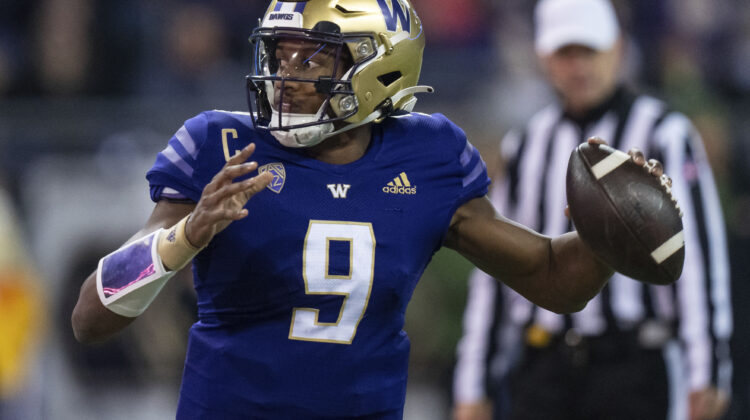A weekly assessment of developments across the Pac-12 …
1. Penix meets Peacock
There was one surprise Wednesday from the release of kickoff times for the Pac-12’s early-season games, and it didn’t come directly from the conference.
Washington’s trip to Michigan State on Sept. 16, a game controlled by the Big Ten and its media partners, will be broadcast exclusively on Peacock, the streaming platform owned by NBCUniversal.
Perhaps the premier non-conference games of Week Three won’t be on FOX’s Big Noon window or ABC’s primetime slot.
It won’t be on broadcast or cable television.
Instead, a preseason top-10 team (UW) with a Heisman Trophy candidate (quarterback Michael Penix) will face an upper-level Big Ten program on a streaming service with just 20 million subscribers (approximately).
Most UW fans will need to find the remote control and break out the credit card in order to watch the 2 p.m. kickoff.
Meanwhile, two lesser Big Ten games received better broadcast windows: Syracuse-Purdue is slotted for primetime on NBC; and Western Kentucky-Ohio State is on FOX.
The attractiveness of the Washington-MSU matchup is the very reason NBC opted for an exclusive broadcast on Peacock. It wants to drive viewers to the streaming platform and is using premium Big Ten football as a means to that end.
Both Michigan and Penn State are slotted for Peacock broadcasts in September.
2. Market trend
The Washington-MSU matchup is merely the latest example of media companies shifting their football inventory to streaming platforms — a trend that will accelerate in a few years when ESPN itself becomes a streaming service.
(It’s not just college football for NBC’s subsidiary: Peacock has the exclusive rights to an NFL regular-season and playoff game.)
The Pac-12’s next media rights agreement likely will have a significant streaming component, whether it’s Apple or Amazon or ESPN or another service.
So we wonder: What if Washington’s appearance on Peacock is a glimpse into the Pac-12’s future? What if NBC is bidding on a package of Pac-12 games (most of them bound for Peacock) that would complement its Big Ten inventory?
It could work as the second half of a Saturday doubleheader, with the Big Ten game airing at 4:30 p.m. (PT) and then a Pac-12 matchup at 7:30 or 8 p.m.
Perhaps that’s not the likely outcome of the Pac-12’s media negotiations. But until the saga reaches a resolution, it’s foolish to ignore scenarios that haven’t been popular on the rumor mill.
In fact, clarity often comes when we peer into the silence.
3. Three for two
All in all, the Pac-12 will receive significant television exposure for the start of the most anticipated season in recent memory. As many as six teams could appear in the AP preseason poll — Washington, USC, Utah and Oregon are locks; Oregon State is likely; UCLA are possibilities — and the lineup of quarterbacks is stellar.
Across the opening weeks, when non-conference matchups dominate, eight games will be shown on broadcast television — a total that compares favorably (by percentage) to other Power Five leagues, according to a Fox Sports report.
The heaviest concentration comes in Week Two, when Pac-12 teams will appear on three broadcast networks at the same time — and in prime time on the East Coast, no less.
Oregon’s trip to Texas Tech (FOX) kicks at 4 p.m. (Pacific), followed by Washington State’s date with Wisconsin (ABC) and UCLA’s visit to San Diego State (CBS) at 4:30 p.m.
4. Reverse pivots
The Pac-12 received a barrage of encouraging news prior to the deadline for players to withdraw from the 2023 NBA Draft.
Colorado’s Tristan da Silva, Utah’s Branden Carlson and UCLA’s Adem Bona — each an all-conference honoree — were among the players opting to return for the 2023-24 season.
And Arizona landed a major transfer when guard Caleb Love, who helped lead North Carolina to the 2022 NCAA title game, announced he would spend his senior season in Tucson.
The bottom of the conference continues to look wobbly. But the outlook has brightened considerably for the top half.
5. Courtroom matters
It was a busy week for the Pac-12 on the legal front, as well.
The Holiday Bowl reportedly is suing the conference, along with UCLA and the UC Board of Regents, for damages stemming from the cancellation of the 2021 game.
Perhaps you recall the situation: Approximately five hours before kickoff, the Bruins backed out of the game because of a spate of positive COVID tests that left them perilously thin on the defensive line. This, after the program had participated in several days of game-related activities and given no indication of trouble.
Well, the Holiday Bowl suffered an obvious financial hit, tried to recoup the losses by withholding a payment to the Pac-12 following the 2022 game … and, well, the situation ended up in court.
Game organizers are seeking at least $3 million in damages, according to the L.A. Times.
Our view:
Had the Holiday Bowl paid close attention to the manner COVID was handled by UCLA’s football program, athletic department and campus administration — not to mention L.A. County — then the bowl should have been prepared for exactly the situation that flared on game day.
6. Legislative affairs
The week’s other legal development unfolded in Sacramento, where the California state assembly passed AB 252, the College Athlete Protection Act.
As currently crafted, the bill is designed to create a revenue-sharing arrangement between the players and their athletic departments.
It could have massive consequences for the NCAA’s economic model by forcing schools to divert their media revenue, which helps fund the Olympic sports, to the athletes themselves.
(Every university system in California opposes the legislation, as does the Pac-12.)
The bill sailed through the higher education and appropriations committees but encountered resistance on the assembly floor.
Now, it moves to the senate and, potentially, to Gov. Gavin Newsom.
We suspect the revisions made to survive the assembly won’t be the last changes.
Related posts:
 Pac-12 rewind: Shaw steps down, Dillingham steps in, Williams shines and Washington turns the knife
Pac-12 rewind: Shaw steps down, Dillingham steps in, Williams shines and Washington turns the knife  Pac-12 football: The Hotline’s picks for individual awards and the all-conference teams
Pac-12 football: The Hotline’s picks for individual awards and the all-conference teams 
(AP Photo/Ralph Freso, File)
Pac-12 media rights strategy: The market has spoken; time to cut a deal Pac-12 media rights: Kliavkoff has made no secret about his strategy (and interest in streaming companies)
Pac-12 media rights: Kliavkoff has made no secret about his strategy (and interest in streaming companies)
